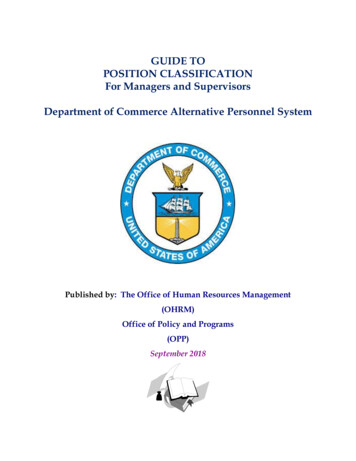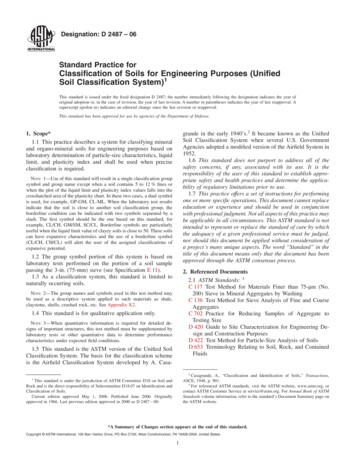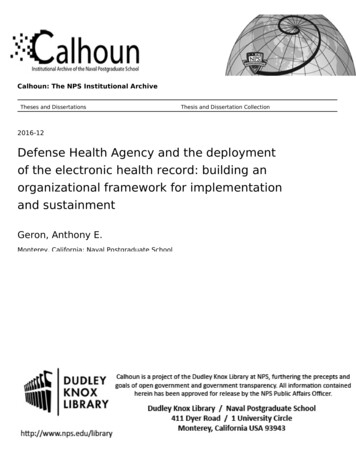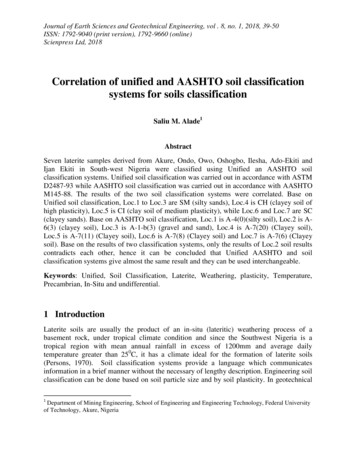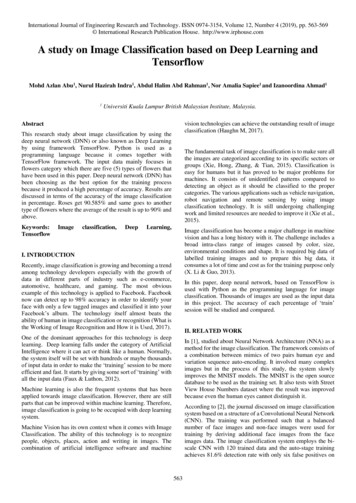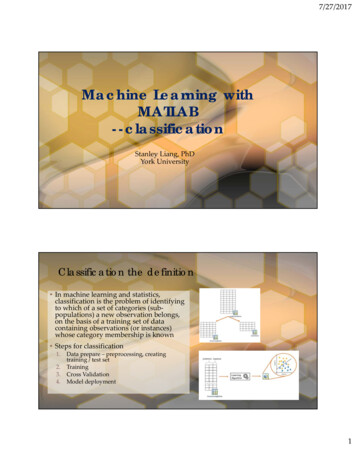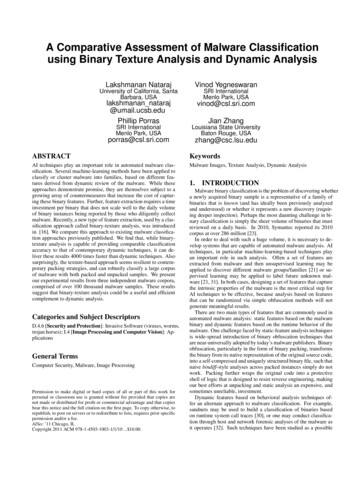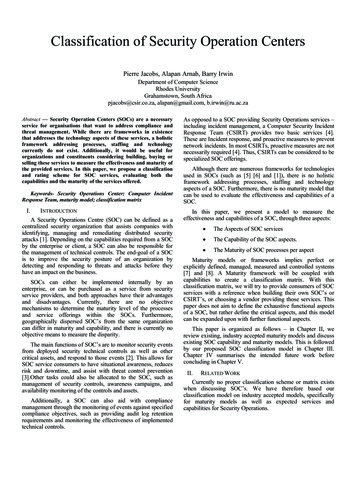
Transcription
Classification of Security Operation CentersPierre Jacobs, Alapan Arnab, Barry IrwinDepartment of Computer ScienceRhodes UniversityGrahamstown, South Africapjacobs@csir.co.za, alapan@gmail.com, b.irwin@ru.ac.zaAbstract — Security Operation Centers (SOCs) are a necessaryservice for organisations that want to address compliance andthreat management. While there are frameworks in existencethat addresses the technology aspects of these services, a holisticframework addressing processes, staffing and technologycurrently do not exist. Additionally, it would be useful fororganizations and constituents considering building, buying orselling these services to measure the effectiveness and maturity ofthe provided services. In this paper, we propose a classificationand rating scheme for SOC services, evaluating both thecapabilities and the maturity of the services offered.Keywords- Security Operations Center; Computer IncidentResponse Team, maturity model; classification matrixI.INTRODUCTIONA Security Operations Centre (SOC) can be defined as acentralized security organization that assists companies withidentifying, managing and remediating distributed securityattacks [1]. Depending on the capabilities required from a SOCby the enterprise or client, a SOC can also be responsible forthe management of technical controls. The end-goal of a SOCis to improve the security posture of an organization bydetecting and responding to threats and attacks before theyhave an impact on the business.SOCs can either be implemented internally by anenterprise, or can be purchased as a service from securityservice providers, and both approaches have their advantagesand disadvantages. Currently, there are no objectivemechanisms to determine the maturity level of the processesand service offerings within the SOCs. Furthermore,geographically dispersed SOC’s from the same organizationcan differ in maturity and capability, and there is currently noobjective means to measure the disparity.The main functions of SOC’s are to monitor security eventsfrom deployed security technical controls as well as othercritical assets, and respond to those events [2]. This allows forSOC service consumers to have situational awareness, reducesrisk and downtime, and assist with threat control prevention[3].Other tasks could also be allocated to the SOC, such asmanagement of security controls, awareness campaigns, andavailability monitoring of the controls and assets.Additionally, a SOC can also aid with compliancemanagement through the monitoring of events against specifiedcompliance objectives, such as providing audit log retentionrequirements and monitoring the effectiveness of implementedtechnical controls.As opposed to a SOC providing Security Operations services –including incident management, a Computer Security IncidentResponse Team (CSIRT) provides two basic services [4].These are Incident response, and proactive measures to preventnetwork incidents. In most CSIRTs, proactive measures are notnecessarily required [4]. Thus, CSIRTs can be considered to bespecialized SOC offerings.Although there are numerous frameworks for technologiesused in SOCs (such as [5] [6] and [1]), there is no holisticframework addressing processes, staffing and technologyaspects of a SOC. Furthermore, there is no maturity model thatcan be used to evaluate the effectiveness and capabilities of aSOC.In this paper, we present a model to measure theeffectiveness and capabilities of a SOC, through three aspects: The Aspects of SOC services The Capability of the SOC aspects. The Maturity of SOC processes per aspectMaturity models or frameworks implies perfect orexplicitly defined, managed, measured and controlled systems[7] and [8]. A Maturity framework will be coupled withcapabilities to create a classification matrix. With thisclassification matrix, we will try to provide consumers of SOCservices with a reference when building their own SOC’s orCSIRT’s, or choosing a vendor providing those services. Thispaper does not aim to define the exhaustive functional aspectsof a SOC, but rather define the critical aspects, and this modelcan be expanded upon with further functional aspects.This paper is organized as follows – in Chapter II, wereview existing, industry accepted maturity models and discussexisting SOC capability and maturity models. This is followedby our proposed SOC classification model in Chapter III.Chapter IV summarises the intended future work beforeconcluding in Chapter V.II. RELATED WORKCurrently no proper classification scheme or matrix existswhen discussing SOC’s. We have therefore based ourclassification model on industry accepted models, specificallyfor maturity models as well as expected services andcapabilities for Security Operations.
A. Industry accepted maturity modelsWhen describing the maturity level of a SOC, it would beprudent to use existing established Information Technology(IT) management framework such as Control Objectives forInformation Technology (CoBIT) and Information TechnologyInformation Library (ITIL), coupled with information securityframeworks such as ISO/IEC 27001. The CoBIT frameworkcovers all aspects of IT in the business, and is supported byITIL, which covers effectiveness and efficiency of operations.The Figure 1 depicts the relationship between differentstandards and frameworks:IT Key concepts, and this is reflected in the fact that theirframework addresses Process Maturity.The five ITIL Process Maturity Framework maturity levels are: 1 Initial 2 Repeatable 3 3Defined 4 Managed 5 OptimisedAccording to Wim Van Grembergen et al [11], “Thecontrol objectives of COBIT indicate for the different ITprocesses what has to be accomplished, whereas otherstandards, such as ITIL, describe in detail how specific ITprocesses can be organised and managed”. It needs to benoted that none of these maturity models addresses risk as partof their levels.The Software Capability Maturity Model (CMM) alsorecognizes five maturity levels The Capability Maturity Model(CMM) focusses on Organizations software processes, and theevaluation of the capability of these processes [12][13].Figure 1: Relationship between Standards, Frameworksand their driversIn order to have a repeatable model, SOC’s will have to beclassified for each aspect (the solutions offered by the SOC),the capability (how much functionality is offered), and thematurity (how well the SOC can deliver the functionality).CoBIT identifies five maturity levels for management andcontrol of IT processes, which allows for benchmarking andidentification of capability improvements. This approach wasderived from the Software Engineering Institute (SEI) [9].The five CoBIT maturity levels are: 0 Non-existent 1 Initial / Ad Hoc 2 Repeatable but Intuitive 3 Defined Process 4 Managed and Measureable 5 OptimizedThese maturity levels are not absolutes, and it is also notsomething which can be measured with 100% accuracy, sincesome implementations will be in place at different levels.These levels will however assist in creating a profile.The ITIL Process Maturity Framework (PMF) alsoidentifies five Process Maturity Levels [10], and as illustratedin Figure 1, ITIL focus more on the Operational aspects of theFigure 2: The Software Capability Maturity Model [12]The National Institute of Standards and Technology (NIST)[14] uses five security maturity levels. These are: IT Security Maturity Level 1: Policies IT Security Maturity Level 2: Procedures IT Security Maturity Level 3: Implementation IT Security Maturity Level 4: Test IT Security Maturity Level 5: IntegrationThe International Systems Security EngineeringAssociation (ISSEA) has developed a Capability MaturityModel (CMM). This is called the Systems SecurityEngineering Capability Maturity Model (SSE-CMM) [15]. Thefive capability levels are: Level 1 – Base practices are performed informally
Level 2 – Base practices are planned and tracked Level 4 – Documented Level 3 – Base practices are well defined Level 5 – Revised and Updated Level 4 – Base practices are quantitatively controlled Level 5 – Base practices are continuously improvingA systematic approach to measuring the maturity of asecurity technical or administrative control should [15]: Generate reproducible and justifiable measurementsof the security posture and service to organization orclient, Measure something of value to the client ororganization, Determine progress in security posture and servicedelivery to clients,Assist in determining the order in which security controlsshould be applied as well as the resources needed to apply thesecurity program.Table 1 summarizes the published Security MaturityModels and their focus [16]. The derived proposed SOCProcess Maturity model is summarized in Table 2.The six step model proposed, is consistent with all thepublished Security Maturity Models, and can be crossreferenced to a more than one model per specific maturitylevel.B. Aspects of a SOCSOC’s provides situational awareness for Organisations ontheir security posture, reduces risk and downtime, preventsand controls threats, ease administrative overhead, serves asan escalation path and assists with audit and compliance [3].In other words, a SOC prevents, detects, reacts, recover fromsecurity related incidents, and in the process assists withcompliance.A SOC receives events from different implementedtechnology solutions, both agentless or with an agent, and thetechnologies could be implemented locally or across ageographically dispersed environment.SOC aspects are numerous, and should constantly beupdated. Aspects describe the functionalities of a SOC, andcapabilities describe how well it performs these functions [18]and [2].To be able to compare different SOCs, it is important todefine aspects against which they can be measured. Aspectscan be grouped into primary and secondary aspects. Primaryaspects are those aspects which will be found in any SOC, andis defining of the main functionality of a SOC. These would bethe minimum functions and aspects an entity should have to beclassified as a SOC. Secondary are those offered over andabove SOC normal functionsWe have derived the following primary aspects through acombination of a number of security management and controlframeworks [19], [20] [6] [21] and [22], including ISO 27000series and SANS Crititcal Controls [2] and [23] . Log CollectionRefers to a centralized collection to security, systemand transactional activity logs. A service with lowcapability in log collection, will provide a best effortservice, with no guarantee in collection; while aservice with high capability in log collection, willprovide a collection guarantee of over 99% ofproduced log events.Table 1: Published Security Maturity Models[16]The CERT/CSO Security Capability Assessment modelconsist of five maturity levels [17]. These are aimed at thequality of documentation. The levels are: Level 1 – Exists Level 2 – Repeatable Level 3 – Assigned Responsibility Log Retention and ArchivalIf a log file contains useful and relevant informationwhich can be used in future, it must be retained. Actsand legal requirements can also demand that logs beretained. A service with low capability will store logsfor a limited time and have size constraints, andstorage will not be forensically secure. A highcapability service will store logs with minimal time orsize constraints, and comply with customer and legal
requirements such as guaranteed recovery and nonrepudiation. This could be both real-time, as well as potentialthreats and vulnerabilities which need to be escalatedand corrective pro-active measures taken to mitigate.The latter will not necessarily be classified asincidents. This is as opposed to reactive behavior tomitigate virus outbreaks or attacks in progress whichis already an incident. Low capability services willhave no in-house research and external threat feedcapability, and a highly capable service will have aresearch contingent with automated, subscribed threatand vulnerability feeds from multiple externalproviders.Log AnalysisRefers to the capability of the SOC to analyse rawdata and present the result as usable, actionable andunderstandable information and metrics. A lowcapability service will be able to present only raw dataand logs from a limited amount and type of devices inlimited formats, and a high capability service will beable to provide metrics and dashboards from a widerange of formats and type of devices. Monitoring of Security Environments for SecurityEvents.According to the ITIL glossary and abbreviations of2011 [24], monitoring is “Repeated observation of aconfiguration item, IT service or process to detectevents and to ensure that the current status is known.”A Service with a low capability will provide basicmonitoring during office hours with no guaranteedresponse levels in place. A highly capable monitoringservice will provide guaranteed services on a 24x7follow the sun principle and can prove improvementin security posture. Threat IdentificationRefers to the capability of a SOC to identify threatsand vulnerabilities either in real time and as part of aresearch capability. A low capability service will havelimited threat identification capabilities, while ahighly capable service will have a research capability,as well as real time querying of integrated 3rd partythreat management systems. ReportingThis refers to the capability of providing securityrelated reports to clients. A Service with a lowcapability will provide out of the box reports inlimited format and platforms, whereas a highlycapable service provides on-demand, ad-hoc, analysedreports to clients in different formats and via differentplatforms.Diversity of devices integratedRefers to the type of devices and vendors which canbe integrated and managed from the SOC. It alsoincludes concepts such as available skillsets within theSOC. A Low capability service will be able tomonitor limited device types from limited vendors,and also have a limited capability to understand andinterpret the vulnerabilities against those device types.A Highly capable service will experience little or norestrictions on the type of devices and vendors tomonitor, and will have the expertise to understandvulnerabilities and threats seen against those devices.Reaction to threats.Secondary aspects are functions which are offered over andabove the primary SOC services. Secondary services include,but is not limited to: Malware analysis Vulnerability ScanningEvent Correlation and Workflow. Vulnerability AnalysisThis refers to the capability to correlate eventsbetween different device types and vendors, as well askick off workflows in response to correlation rulesbeing triggered. Correlation rules could be basic, toAI based automated rules. Services with a lowcapability supplies only basic, manual correlationrules with no workflow capability. A highly capableservice will provide complex, automated correlationrules integrated into enterprise wide workflowsystems. Device Management Identity Attestation and Recertification Penetration testing Type of Industry verticals monitored. Threats againsta Financial Institution’s network will differ from thoseagainst a Supervisory Control and Data Acquisition(SCADA) network. Integration with Physical Security controls.Incident ManagementThis refers to the ability to react to, and escalateincidents. A Service with a low capability willmanually create and react to incidents. Escalation isalso manual. A highly capable service will haveIncident Management and escalation automated, andtracked and managed by integration into enterprisewide incident management systems.The secondary aspects are not exhaustive and are expectedto change over time. Furthermore, secondary aspects couldalso be industry or geographic specific.These aspects will be further defined by their capabilities andmaturity.
III. MODEL FOR SOC MATURITY AND CAPABILITYBased on maturity models discussed previously, wepropose a 6 step maturity model, which we have aligned to themodels discussed previously.LevelNameAlignment0Non ExistentCoBIT 0, etc.1InitialCoBIT, SSE, ITIL:Initial CERT: Exists2Repeatable(CoBIT, ITIL, SSECMM andCERT/CSO)Defined Process(CERT/CSO) / WellDefined (SSECMM), DefinedProcess (CoBIT),Common Practice(CITI-ISEM)Reviewed andupdatedCERT/CSO),Quantitativelycontrolled (SSECMM), Managedand Measureable(CoBIT) andContinuousImprovement (CITIISEM)345more important than the number of capabilities [25].ContinuouslyOptimisedOptimised (CoBIT),ContinuouslyImproving (CITIISEM), ContinuouslyImproving (SSECMM)Table 2: Process MaturityThe cube in Figure 4 will assist in assigning a weight andlevel to SOCs. Due to the importance of Process Maturity, wepropose a slightly higher weighting for Maturity. Maturity ofprocesses is weighted higher than capability, since themaintenance, execution and repeatability of the capability isFigure 4: SOC Classification CubeThe Maturity, Aspects and Capability of SOCs can beexpressed as follows: 0.05Where SOC Score Sum of all applicable aspect scores,where each aspect is scored on Capability and Maturityexpressed as a score out of 100.α 0.4β 0.6This will provide a weighting which can be referencedagainst the provided map. SOC Managers and customersshould strive for a high maturity and high capability level.Based on the business requirements, it would also be possibleto weigh specific aspects higher than others.This will give consumers of SOC services a classificationscheme and reference framework to work from when choosinga partner or building and in-house solution.We have used the above approach, and applied it to rate aknown SOC provider in South Africa, which we are wellacquainted with. The breakdown of the individual aspects asshown in Figure 5, and the total score of the SOC is 46.4.While this particular SOC service has some strong services, themajority of the services are below par, and this is reflected inthe overall score. As discussed in Section IV, we intend toextend this rating formally across multiple providers in SouthAfrica , which would allow us to build a comprehensiveanalysis of the SOC services market in South Africa, includingthe strengths and weaknesses of various players together withthe overall industry norms.
REPORTINGLOG COLLECTIONLOG RETENTIONLOG ANALYSISMONITORINGCORRELATIONDEVICE TYPESINCIDENT MGMTREACTION TO THREATSTHREAT neh Madani et al, “Log Managementcomprehensive architecture in Security OperationCenter(SOC),” 2011 International Conference onComputational Aspects of Social Networks (CASoN),2011. [Online]. Available:http://ieeexplore.ieee.org/xpls/abs all.jsp?arnumber 6085959&tag 1.[2]Kevin Warda, “A Fundamental and Essential look intoManaged Security Services,” SANS (GSEC) PracticalAssignment Version 1.4c – Option 1 March 28, 2005,2005. [Online]. [3]Diana Kelley and Ron Moritz, “Best Practices forBuilding a Security Operations Center,” The (ISC)2Information Systems Security, 2006. al/Kelley.pdf.[4]C. Thompson, “Incident Response and Creating theCSIRT in Corporate America,” SANS Institute InfoSecReading Room, 2001. [Online]. Available:http://www.sans.org/reading ng-csirt-corporateamerica 642.[5]Renaud Bidou, “Security Operation Center Concepts& Implementation,” 2004. [Online]. epts-&implementation.[6]Diana Kelley and Ron Moritz, “Best Practices forBuilding a Security Operations Center,” InformationSecurity Journal: A Global Perspective, 2006.[Online]. .pdf.[7]S. P. M. Ibrahim Al-Mayahi, “ISO 27001 GapAnalysis - Case Study,” 2012. [Online]. apers/WorldComp2012/SAM9779.pdf.[8]Andrea Pederiva, “The COBIT Maturity Model in aVendor Evaluation Case,” Information SystemsControl. Journal, 2003. [Online]. pdf.[9]Mark Adler et al, “CobiT 4.1 Framework,” 2007.[Online]. Available: ts/CobiT 4.1.pdf.[10]Ian MacDonald, “ITIL Process AssessmentFramework,” 2010. [Online]. Available:Table 3: SA MSSP RatingFigure 5: Rating of SA MSSPIV. FUTURE WORKWe plan to verify the completeness of the model, throughengagement with both consumers and providers of SOCservices, and to thereafter classify existing providers in theSouth African environment to understand the currentstrengths, and weaknesses, as an additional verification for themodel.V.CONCLUSIONAfter having done extensive research and literature reviews,no literature or references could be found on an Industryaccepted framework or comprehensive classification schemefor SOCs.Using this proposed classification matrix, it is possible toassign a weighting to SOC capability and maturity levels. Thiscan assist SOC owners in determining their status, as well asidentify where growth and improvement is needed. Customerslooking at making use of SOC services can use this model todetermine the level of service they can expect, as well as toallow them to make an informed decision when signing up forSOC services.ACKNOWLEDGMENTWe would like to thank Schalk Peach and Karel Rode fortheir early review and feedback on the proposed model.REFERENCES
les/ITIL Process AssessmentFramework - MacDonald.pdf.[11][12]Wim Van Grembergen and Steven De Haes,“Measuring and Improving IT Governance Throughthe Balanced Scorecard,” Information Systems ControlJournal, 2005. [Online]. ving.pdf.Bill Curtis et al, “Software Capability Maturity Model(CMM).” [Online]. -maturitymodel.aspx.[21]Michael Protz et al, “A SAS Framework forNetwork Security Intelligence,” 2009. /sugi30/190-30.pdf.[22]Cisco Systems, “Cracking the Code for a SOCBlueprint Architecture, Requirements, Methods andProcesses and Deliverables,” Cisco Networkers, 2006.[Online]. Available: .pdf.[23]ISO / IEC, “ISO/IEC 27001:2005 Informationtechnology -- Security techniques -- Informationsecurity management systems -- Requirements,” 2005.[Online]. AnnexIX1302.pdf.[13]IT Governance, “Software Capability Maturity Model(CMM).” [Online]. -maturitymodel.aspx.[14]NIST, “Security Maturity Levels,” 2012. /prisma/security maturity levels.html.[24]Ashley Hanna, “ITIL glossary and abbreviations,”2011. [Online]. Available: ialog.aspx?lid 1180&.[15]Mike Phillips, “Using a Capability Maturity Model toDerive Security Requirements,” 2003. [Online].Available:http://www.sans.org/reading l-derive-securityrequirements 1005.[25][16]Steven Akridge and David A.Chapin, “How CanSecurity Be Measured?,” Information Systems Auditand Control Association., 2005. [Online]. px.K. Chung, “People and Processes More Important thanTechnology in Securing the Enterprise, According toGlobal Survey of 4,000 Information SecurityProfessionals,” 3rd Annual (ISC) 2-Sponsored GlobalInformation Security Workforce Study says AsiaPacific offers attractive employment incentives andopportunities for information security professionals,2006. [Online]. .aspx?id 2714.[17]M. Sajko, “Measuring and Evaluating theEffectiveness of Information S ecurity,” 2007.[Online]. ]Reply Communication Valley, “SECURITYOPERATION CENTER.” [Online]. Available:http://www.reply.eu/1937 img COMVR11 SOC eng[19]D. Del Vecchio, “The Security Services a SOC shouldprovide,” 2012. [Online]. 9/thesecurity-services-of-soc.html.[20]Cisco Systems, “How to Build Security OperationsCenter (SOC),” 2007. [Online]. Available: ion-
The ITIL Process Maturity Framework (PMF) also identifies five Process Maturity Levels [10], and as illustrated in Figure 1, ITIL focus more on the Operational aspects of the IT Key concepts, and this is reflected in the fact that their framework addresses Process Maturity. The five ITIL Process Maturity Framework maturity levels are:
